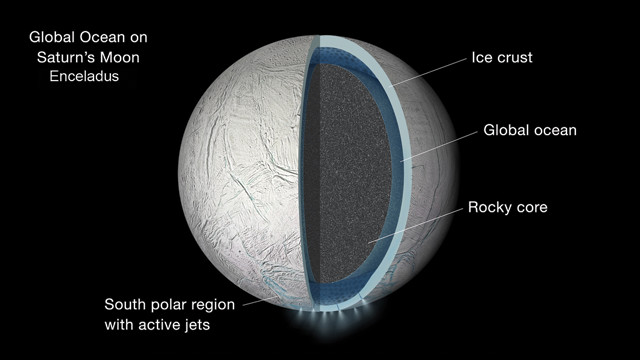
by Mary Caperton Morton Tuesday, February 27, 2018

Friction produced by tidal forces acting on Enceladus' highly fragmented, porous core could produce enough heat to sustain the moon's liquid ocean. Credit: NASA/JPL-Caltech.
Saturn’s sixth-largest moon, Enceladus, is covered by ice, but just beneath its icy surface lies an ocean of liquid water. New research suggests that this internal ocean may be maintained in a liquid state by heat generated by tidal friction within the moon’s fragmented, rocky core.
During its two-decade-long mission, the Cassini spacecraft revealed that Enceladus’ icy crust is underlain by intense hydrothermal activity. Chemical analysis of liquid escaping through the crust in massive hydrothermal geysers at the moon’s south pole demonstrated that the moon’s ocean is salty and rich in organic molecules. Initially, geologists thought that the liquid ocean might be sustained by tidal forces generated within the moon’s icy crust, but modeling suggested that without another heat source, the ocean would have frozen within 30 million years after its formation.
In a study in Nature Astronomy, new modeling by Gaël Choblet of the University of Nantes in France and colleagues suggests that friction produced by tidal forces acting on the moon’s highly fragmented, porous core could produce enough heat to sustain the moon’s liquid ocean for tens of millions to billions of years. The model fits with many other properties observed by Cassini, such as increased thinning of Enceladus’ icy shell at its poles, where interior heat would preferentially dissipate. Whether this ancient liquid ocean has the conditions necessary to support life remains to be explored by future missions.
© 2008-2021. All rights reserved. Any copying, redistribution or retransmission of any of the contents of this service without the expressed written permission of the American Geosciences Institute is expressly prohibited. Click here for all copyright requests.